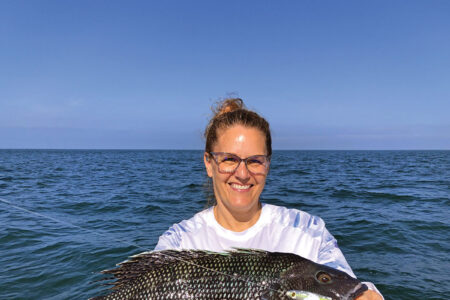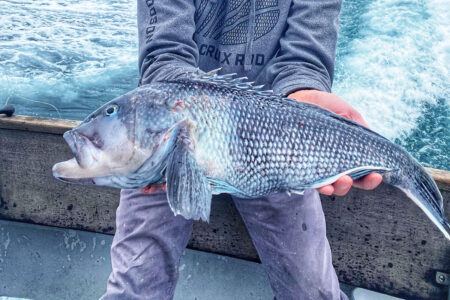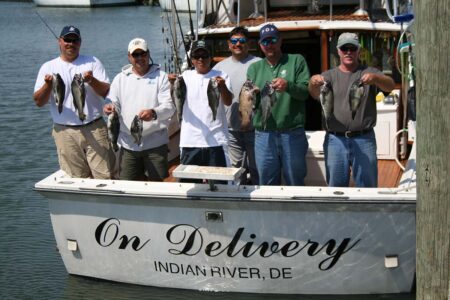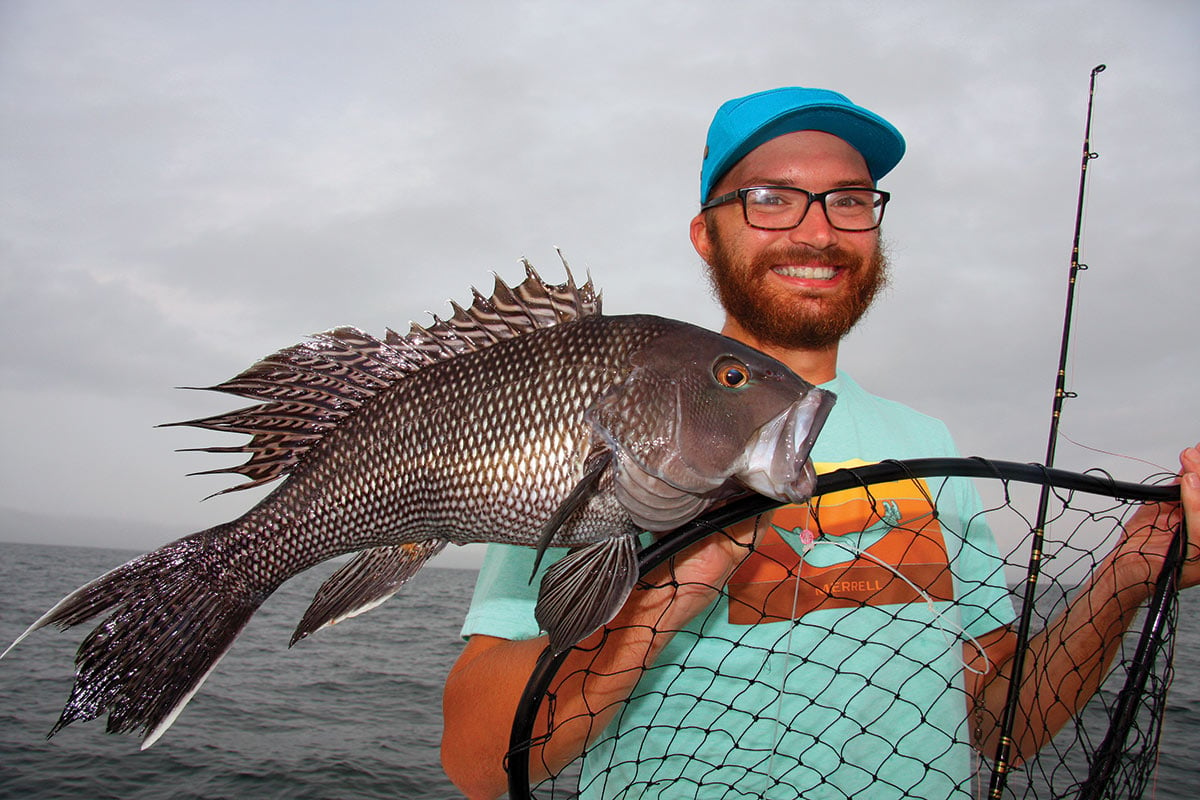
While diamond jigs are great for picking bull sea bass from deep water, go with bait to take home an easy limit of keepers.
Diamond and bucktail jigs can be deadly for attracting big, humpie sea bass in deep water, but the average angler is happy to take home a limit of average-size keepers for the skillet. And given the choice, he or she would probably rather fish nearshore in shallower water with lighter gear. Using diamond jigs, which are very effective for keeping shorts at bay, also requires a subtle and specific action many anglers aren’t adept at performing. That narrows down the techniques to the best chance for success, which is baitfishing. Here are some sea bass basics the pros use to put fish in the cooler each trip, along with some helpful and unique facts about the species.
Want to Catch a Grouper?
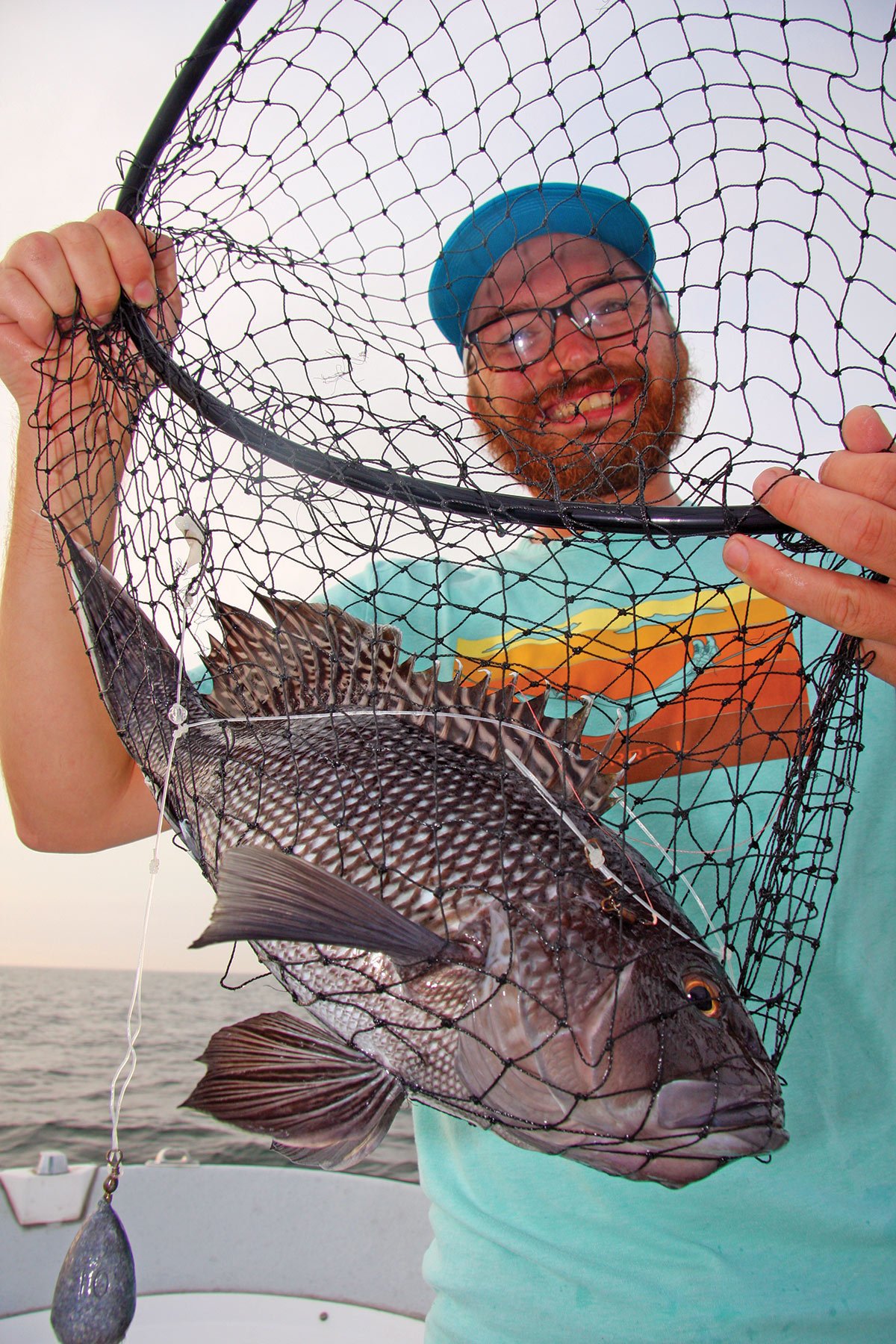
The black sea bass (Centropristis striata), not to be confused with other species of saltwater bass is an excellent eating fish. It’s strictly a marine species; therefore, unlike striped bass it doesn’t migrate into estuaries to spawn. To inexperienced seafood diners ordering “sea bass” in restaurants, they’re most often served Patagonian toothfish, (Dissostichus eleginoides), marketed as Chilean sea bass (or just “sea bass”), a large and ugly fish with an equally unappetizing name, found only in cold waters (34 to 39 degrees in the sub-Antarctic), which are currently overharvested, often illegally. The name “Chilean sea bass” was randomly invented in 1977 by a fish wholesaler to make the species sound more appealing and popular to the finicky US market. To help protect this overexploited fish, don’t order that entrée or purchase it from a fish market.
Our species of sea bass is technically a type of grouper (Serranidae family), which inhabits coastal waters from Maine to Florida and the eastern Gulf of Mexico. Fortunately, sea bass are abundant from Massachusetts through New Jersey. Although they range offshore to depths of over 400 feet in summer, they are most common in waters of 25 to 120 feet deep. Many anglers catch plentiful sea bass in inshore waters in the spring. Because of its fine table qualities, as well as dwindling numbers of other bottom fish species, local anglers have begun heavily targeting sea bass over recent years. With climate change and warming waters as the likely cause, the main biomass of sea bass has gradually moved northward from North Carolina to New Jersey and southern Massachusetts. Regular catches are occurring as far north as the Gulf of Maine, which was rare to non-existent 10 years ago.
Sea bass typically weigh about 1-1/2 pounds, but any specimen of 5 pounds or more is noteworthy and will likely land you a coveted spot on the Dream Boat leader board! Pros call large sea bass “humpbacks” or “humpies” because big ones grow a significant hump behind their head. Although sea bass are basically “black,” their color fluctuates according to the bottom they inhabit and sometimes appear a dark olive-brown.
Where and When to Find Them
Black sea bass make excellent sport fish because they are extremely opportunistic feeders, strike aggressively and fight hard all the way to the surface. Their varied diet consists of crustaceans, sea worms, small fish, squid and even bivalves, so a variety of baits, including clams, squid and baitfish produce well. In fact, sea bass are so aggressive they’re blamed for impacting the local lobster population because they prey voraciously on juveniles.
Although not true schooling fish, pros find sea bass in large clusters on structures like shallow wrecks, reefs and rock piles during spawning and migration periods. Adults migrate inshore and northward as water temperatures increase in the spring. Perhaps astonishing, sea bass are protogynous hermaphrodites, which means they’re born as females and turn into males at 2 to 5 years old.
Scientists believe the northern population of black sea bass spawns inshore from mid-May to July between Massachusetts and New Jersey, although some experts believe the spawn lasts into August in cooler areas of our region. The fish then return to deeper waters, moving south and offshore as ocean temperatures drop in the fall. That means the time to prepare to target them is now.
How to Catch ‘Em
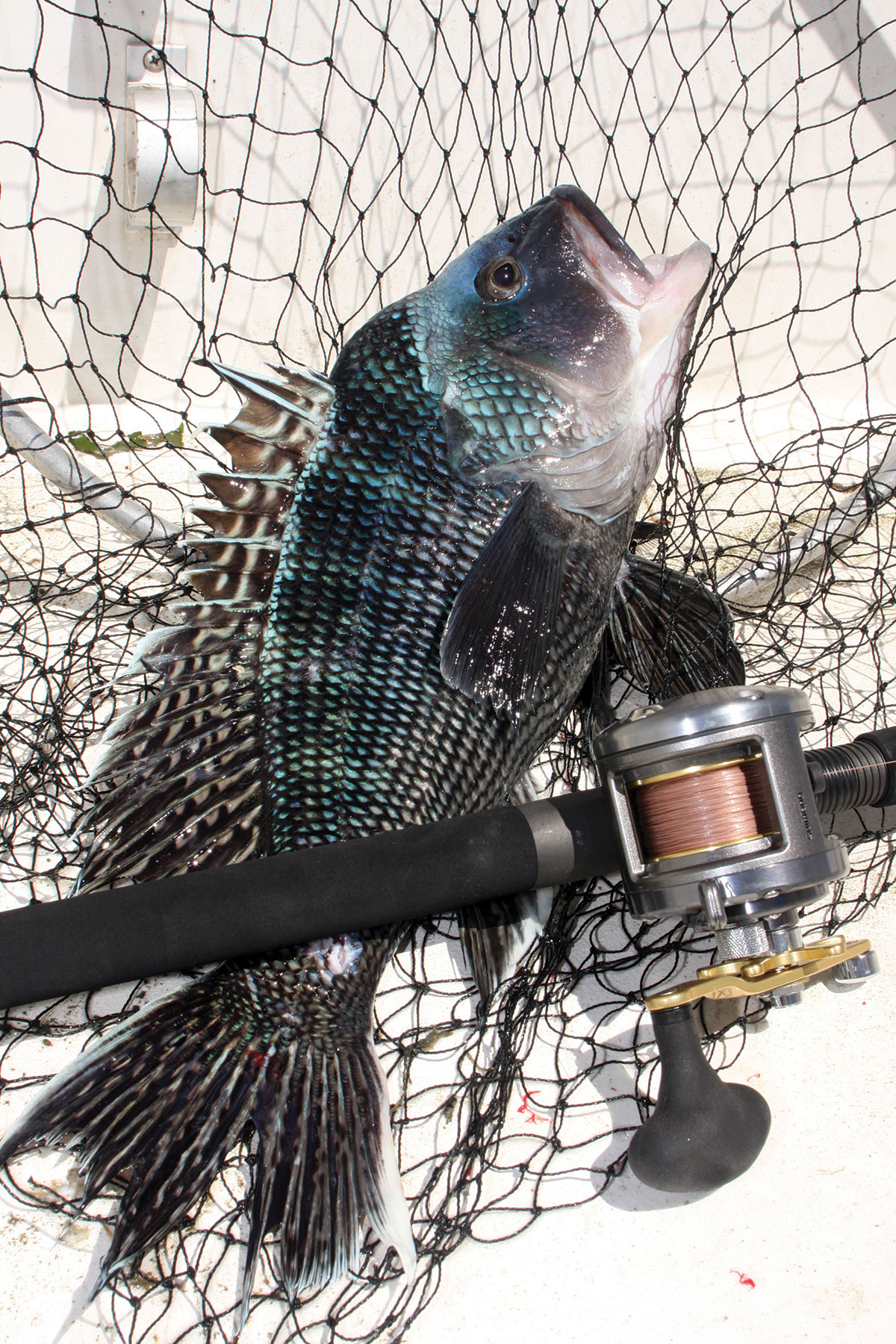
because they are extremely opportunistic feeders, strike aggressively and fight hard all the way to the surface.
Catching sea bass isn’t complicated but requires some technique to consistently take home a limit. A productive rig is as simple as using thinly-chunked sea herring skewered onto a standard high-low rig consisting of two snelled, 4/0 bait-holder hooks and a suitable bank sinker. Although an excellent variety of high-low rigs are available in tackle shops, many anglers prefer to build their own.
To make a simple, do-it-yourself rig, start with 24 to 30 inches of 30- to 50-pound mono leader. Attach one end to a #75-#100 barrel swivel, which is used to connect to the main line. Create a large loop in the other end, which is used for sinker change-outs. Tie in two or three evenly-spaced droppers, using the dropper-leader length to determine the best distances from the sinker and between the droppers. Tie 2/0-4/0 baitholder hooks to each dropper leader (or just buy snelled sea bass hooks). Bait up with clam, squid or herring chunks, and you’re ready to fish. Specialty rigs can vary greatly.
For example, instead of plain bait hooks on your droppers, you could tie on large saltwater flies, like 2/0 clousers or deceivers, which work well in this same application, as do a variety of squid-like or flutter-tail soft plastics, all tipped with fresh bait strips.
Sabiki Style
One of the most effective sea bass rigs ever created is that made by Coleman’s Fishing Supply (“Squid Jig Warehouse”) in Auburn, Washington. This sabiki-style rig consists of two soft plastic squid (which glow in the dark), with a touch of flashabou and hackle feathers tied in, dressed over 3/0 circle hooks. The circle hooks help reduce snags and gut hooking. Colman’s uses a 60-pound main line and 50-pound droppers to handle big sea bass on rough bottoms. You can find and order these at www.squidjig.com.
How to Fish your Rigs
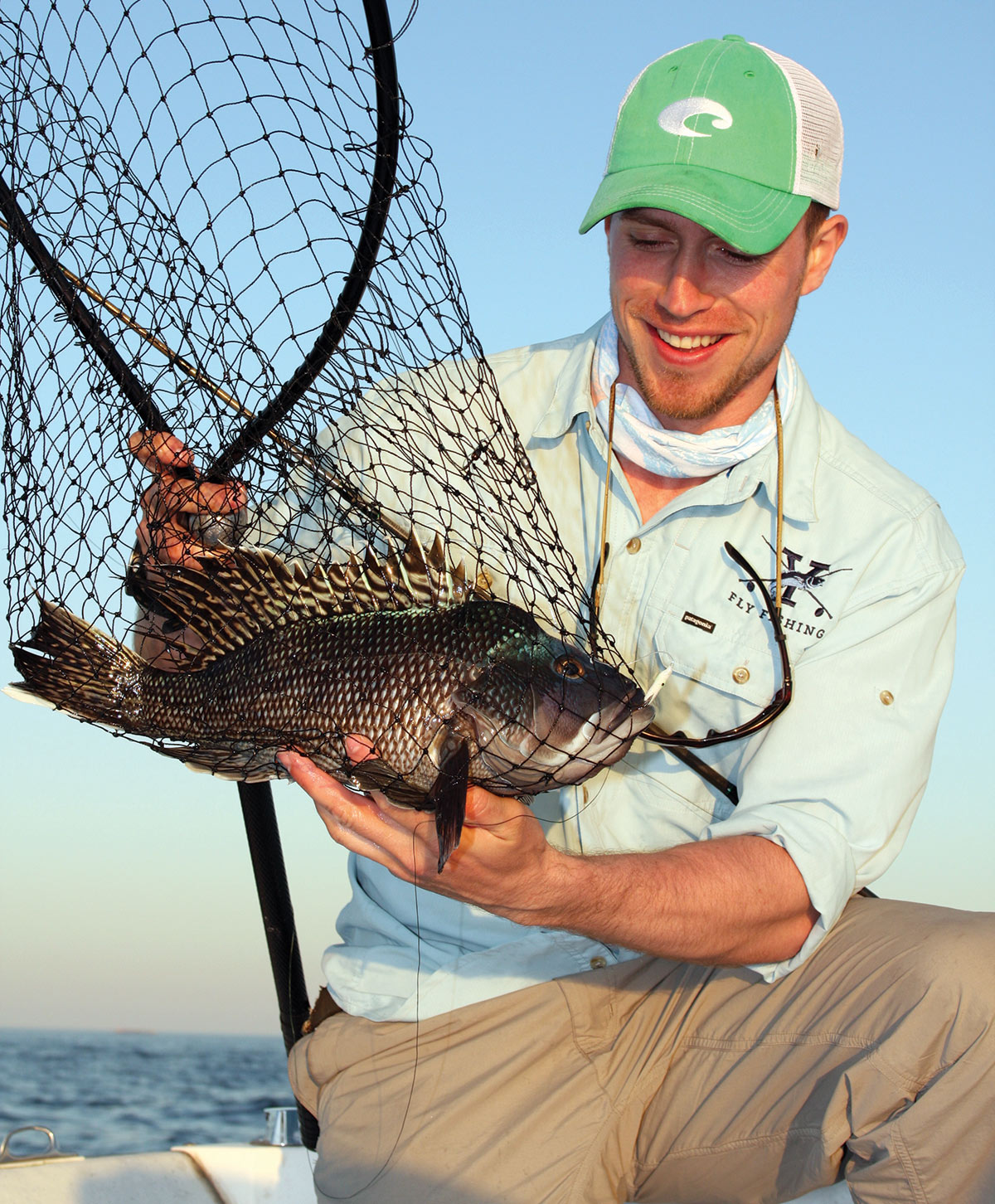
Because sea bass are aggressive, fishing methods vary and most are successful. The most common technique is to simply anchor over likely structure, and if shallow enough use a chum pot, draw fish to your fresh-baited hooks. But most pros drift rather than anchor.
“I never anchor up for sea bass,” said expert Elliott Taylor. “That’s because if a spot is unproductive, or full of undesirable species, it’s easy and fast to run to another reef. I don’t have to wrestle with anchor setting and hauling. Drifting also allows you to fire the motor to run back up-current to pull out snagged rigs or repeat hot drifts over a bunch of fish. You’ll know immediately if you’re on a school because the bites come hard and fast. You can also spot clusters on your fishfinder. “Free-spool your rig until the sinker bumps bottom, immediately engage your reel and take a turn or two up. The trick is to maintain contact with the structure, tapping bottom as you drift, without letting your rig drag and get stuck. Use just enough weight to maintain bottom.”
For inshore spots bring a 2/0 to 3/0 conventional reel matched to a medium-action conventional rod. I like a Shimano Tekota 500 reel spooled with 20- to 30-pound braid and attached to a Lamiglas 6-foot 6-inch 12- to 25-pound rod. This type of all-purpose outfit comfortably handles 3 to 6 ounces of lead, and it’s a nice match for bluefish if they show up on the reef. It’s then a simple matter to switch over to a diamond jig and have a shot at both species without tearing up your baitfish rigs.
Table Prep
Although most anglers associate “bleeding out” a fish with larger species, bleeding or gutting your sea bass before icing them will greatly improve the quality of the flesh.
“Because of their tough scales and slime coat,” said Capt. Kerry Douton, owner of J&B Tackle and the charter boat Dot-E-Dee in Niantic, CT, “sea bass are hard to handle and fillet. But they’re much easier to clean if you fill a cooler with ice and sea water to brine them—that firms the flesh, and the fillets slide off the bone. My crew also places them on burlap so they don’t slip as much on the cutting board. Remember to touch up your knife blade often, too. But for eating, they can’t be beat in a frying pan or served as summer-style ceviche.”

